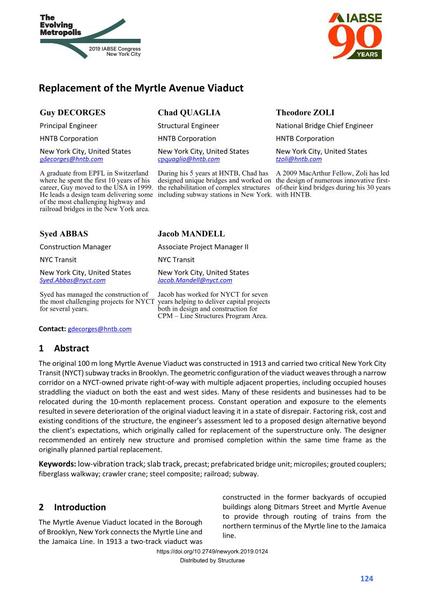Replacement of the Myrtle Avenue Viaduct

|
|
|||||||||||
Bibliographic Details
| Author(s): |
Guy Decorges
(HNTB Corporation)
Chad Quaglia (HNTB Corporation) Theodore Zoli (HNTB Corporation) Syed Abbas (NYC Transit) Jacob Mandell (NYC Transit) |
||||
|---|---|---|---|---|---|
| Medium: | conference paper | ||||
| Language(s): | English | ||||
| Conference: | IABSE Congress: The Evolving Metropolis, New York, NY, USA, 4-6 September 2019 | ||||
| Published in: | The Evolving Metropolis | ||||
|
|||||
| Page(s): | 124-130 | ||||
| Total no. of pages: | 7 | ||||
| DOI: | 10.2749/newyork.2019.0124 | ||||
| Abstract: |
The original 100 m long Myrtle Avenue Viaduct was constructed in 1913 and carried two critical New York City Transit (NYCT) subway tracks in Brooklyn. The geometric configuration of the viaduct weaves through a narrow corridor on a NYCT-owned private right-of-way with multiple adjacent properties, including occupied houses straddling the viaduct on both the east and west sides. Many of these residents and businesses had to be relocated during the 10-month replacement process. Constant operation and exposure to the elements resulted in severe deterioration of the original viaduct leaving it in a state of disrepair. Factoring risk, cost and existing conditions of the structure, the engineer’s assessment led to a proposed design alternative beyond the client’s expectations, which originally called for replacement of the superstructure only. The designer recommended an entirely new structure and promised completion within the same time frame as the originally planned partial replacement. |
||||
| Keywords: |
railroad steel composite precast micropiles subway low-vibration track slab track prefabricated bridge unit grouted couplers fiberglass walkway crawler crane
|
||||

